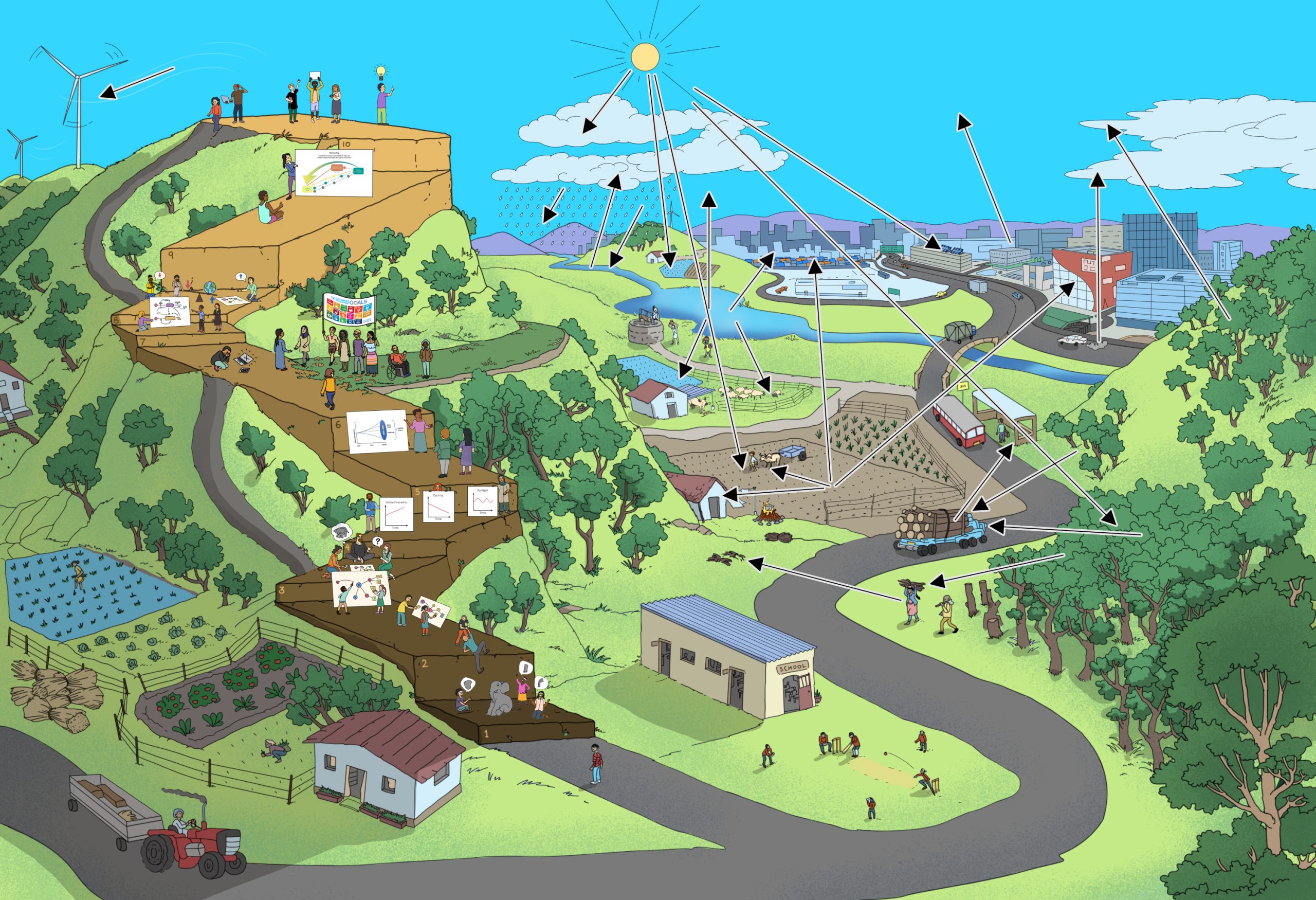Systems thinking is the ability to describe and/ or visualise a part of a complex reality, express that part of reality as a model, understand the model as a system, use the model to explain the behaviour of the system, anticipate the behaviour of the system, and evaluate its impacts on sustainable development, identify potential points of, and types of interventions, generate options to act, assess their impacts in the frame of sustainable development, and decide whether further actions are necessary or not
1. What does this mean?
Having prepared a model in Step 2, learners review whether it depicts a static or dynamic (changing) reality. Next, learners assess if the model they have developed, (or are given, in case the facilitator so decides)represents a system.
What is a “system”?
The Greek called a unit put together out of various elements or components “systema”, from which the word “system” has been derived. In our contemporary understanding, a “system” is understood as a coherent or functional unit incorporating many different factors and drivers, which are interconnected and interdependent. A system is more than the sum of its parts. A forest is a type of ecosystem, and therefore much more than a simple sum of the number of its trees.
Any system has:
- elements
- interrelationships between the elements
- function or purpose
Systems show typical behaviours or patterns of change such as causal or feedback loops, growth, or decay (reinforcing) in linear or exponential manner, or oscillations, or stabilising (balancing) behaviour.
The behaviour of a system are the expected changes over time, as long as it is allowed to function normally. For example, the seasons are a normal behaviour of the climate system.
It is the structure of the system itself, and therefore the nature of interactions among the elements that causes development and change.
A system is dynamic, though the whole system can also come to a stand-still and behave in a static manner for a certain period of time. For example, the climate, the economy, society, factories, farms, schools, and nature are systems. A bicycle which is stationary and not being handled by a rider, is also a system; standing still or having no movement is a particular instance of the behaviour of a system.
Systems can be self-organizing, self-repairing over at least some range of disruptions. They are resilient, and many of them are evolutionary.
Systems thinking requires a specific vocabulary; the terms that may be introduced in this step 3 are:
- element
- interrelationships and causation
- function
- system
- dynamic
- boundary
- Behaviour
- Systems are nested within a larger system, for example a different culture.
- Stocks and flows
(For more details please refer to Thinking in Systems by Donella Meadows, published by the Sustainability Institute, 2008).
https://donellameadows.org/systems-thinking-resources
2. What is the aim?
To enable learners
- to understand whether the chosen topic is a system or not, and whether the system is static or dynamic in nature?
- becoming familiar with and use the specific vocabulary of systems approaches (such as element, interrelationship, function, system, dynamism, etc.)
- identifying elements such as actors or factors of the chosen topic,
- identifying interrelationships among elements in the chosen topic, such as processes, communications, energy or information flows, cultural norms, legislations, or rules,
- understanding that co-functioning elements and interrelationships cause dynamism of systems,
- understanding that a system has integrity (functions as a unit) and has a boundary,
- understanding that a system may be nested as a ‘sub-system’, within another system, or even within other systems,
- listing the outputs of the system/ subsystems
- identify a range of systems in their own contexts and in the world.
4. Activities, tasks and suggested learning methods
In this step, the learners use the model prepared in Step 2 to understand it as a system.
- The learners may initially be engaged in a brief discussion of examples of obvious systems as well as the not so obvious ones:
- Examples of a range of obvious small and large systems, physical to social-ecological, such as a bacterium, ants nest, a pasture, a grocery shop, a school, the transportation system of a city, the climate system.
- Bicycle – Are the parts of a bicycle a system? Is a bicycle a system? Are a bicycle and its rider together a system?(The parts of a bicycle separated out are not a bicycle; however, they are part of the earth system just like billions of other physical objects.).
- Objects by themselves, and collections of objects arranged in relationships – are these systems?
- Wind chimes
- A building, a building with its occupant
- A painting on a wall; a painting with a viewer(Yes, they are!)
- You may also share systems examples from Step 3 in Chips or Jeans.
- Learners should check whether the model they prepared in the previous step is static or dynamic. In case they recognize missing knowledge to depict their model, they may conduct an interview, or search the internet, or refer to appropriate literature.
- To get a better understanding of the progress of your learners, ask:
- What drives the behaviour of a system?
- Do they realise that there is a feedback process involved in the behaviour of systems?
- Finally, the learners should develop:
- A description of (parts of) the model using systems vocabulary,
- System(s) diagram(s), including causal loops to represent dynamism (see the method Understanding Causation).
Learning methods to support the Activity:
5. Conclusion
- Reflect on what is learnt, either by summarizing the activity or asking learners to do so.
- Reflect about the model – if it is static or dynamic.
- Reflect on the process of synthesizing knowledge or information, expressing it, and gathering additional information from others.
- Ask the group to think about and share further questions.
- The answers to these further leading questions may be discussed in the next steps.
Illustration of staircase model for further leading questions
6. Suggested Further Leading Questions
- What is the use of representing reality as a system?
- Does the behaviour of the system remain the same over time, or does it change?
- What drives the behaviour of a system?



